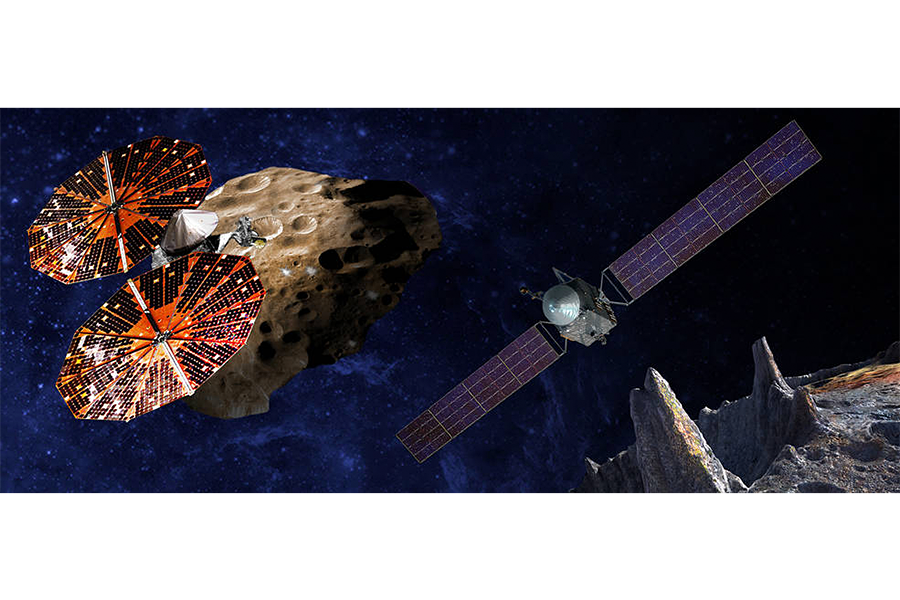 January 4, 2017
January 4, 2017
— From the project that brought you Mars Pathfinder, MESSENGER, Dawn, Kepler, and GRAIL, come Lucy and Psyche.
NASA announced Wednesday that the next two missions of the agency’s Discovery Program will send spacecraft to mysterious asteroids , as scientists hunt for clues into the early days of our solar system.
The Lucy mission’s destination will be Jupiter’s Trojan asteroids, and the Psyche mission will be off to a larger, metal asteroid unlike other space rocks that NASA missions have targeted.
„These are true missions of discovery that integrate into NASA’s larger strategy of investigating how the solar system formed and evolved ,“ Jim Green, NASA’s planetary science director, said in a press release. „We’ve explored terrestrial planets, gas giants, and a range of other bodies orbiting the sun. Lucy will observe primitive remnants from farther out in the solar system, while Psyche will directly observe the interior of a planetary body. These additional pieces of the puzzle will help us understand how the sun and its family of planets formed, changed over time, and became places where life could develop and be sustained – and what the future may hold. “
The robotic spacecraft of the Lucy mission will take off first, in October 2021. In 2025 it will swing by a main belt asteroid, then go on to study six of the Trojan asteroids from 2027 to 2033.
The Trojan asteroids are particularly fascinating for astronomers because they are trapped in the pull of Jupiter’s gravity, but do not orbit the planet as you might expect. Instead, the Trojans form two swarms, one leading and one trailing Jupiter. As the planet goes on its 12-year orbit around the Sun, these asteroids go along with it.
Researchers think the Trojan asteroids formed long ago, possibly far away from their current Jupiter-accompanying orbit. As such, „This is a unique opportunity,“ Harold F. Levison, the principal investigator of the Lucy mission from the Southwest Research Institute in Boulder, Colo., said in a press release. „Because the Trojans are remnants of the primordial material that formed the outer planets, they hold vital clues to deciphering the history of the solar system. Lucy, like the human fossil for which it is named, will revolutionize the understanding of our origins. “
The Psyche mission will also send a robotic spacecraft to search for clues into planetary formation in the early history of our solar system. Its target, a 130-mile-wide asteroid called 16 Psyche that sits in the main asteroid belt, is unique in that it is thought to be made up mostly of metallic iron and nickel – much like Earth’s core.
That makes 16 Psyche particularly intriguing because it could tell researchers something about how rocky, layered worlds like our own form. Perhaps 16 Psyche is even an exposed core of an early planet as large as Mars, scientists have mused. In that scenario, the asteroid would have been stripped of its outer layers by violent collisions billions of years ago.
„This is an opportunity to explore a new type of world – not one of rock or ice, but of metal,“ Lindy Elkins-Tanton, Psyche’s principal investigator and a professor at Arizona State University, said in the press release. „16 Psyche is the only known object of its kind in the solar system, and this is the only way humans will ever visit a core. We learn about inner space by visiting outer space. “
„This is what Discovery Program missions are all about – boldly going to places we’ve never been to enable groundbreaking science,“ Thomas Zurbuchen, associate administrator for NASA’s Science Mission Directorate in Washington, said in the press release.
The launch for the Psyche mission is scheduled for October 2023. On its way to the asteroid, the spacecraft is scheduled to fly by Mars in 2025 before arriving at 16 Psyche in 2030.
NASA is also keeping an eye on asteroids that might be unnervingly near Earth. NASA also announced Wednesday that funding for the Near Earth Object Camera (NEOCam) project is being extended for another year. The mission, which looks out for asteroids that might be a threat to Earth, was first selected in 2010.
The Lucy and Psyche missions join a portfolio of 12 missions in the Discovery Program, which is designed to launch smaller, less-resource demanding missions to complement NASA’s larger missions. Development for the missions is capped at about $450 million.
In the past, the Discovery Program has launched missions to study Mars, stardust, comets, the moon, Mercury, solar wind, and other asteroids. The Kepler space telescope that hunts for potentially habitable planets outside our solar system is also one of Discovery’s missions. The OSIRIS-REx mission,which launched in September 2016, is set to arrive at the asteroid Bennu in 2018 and return a sample back to Earth in 2023.






